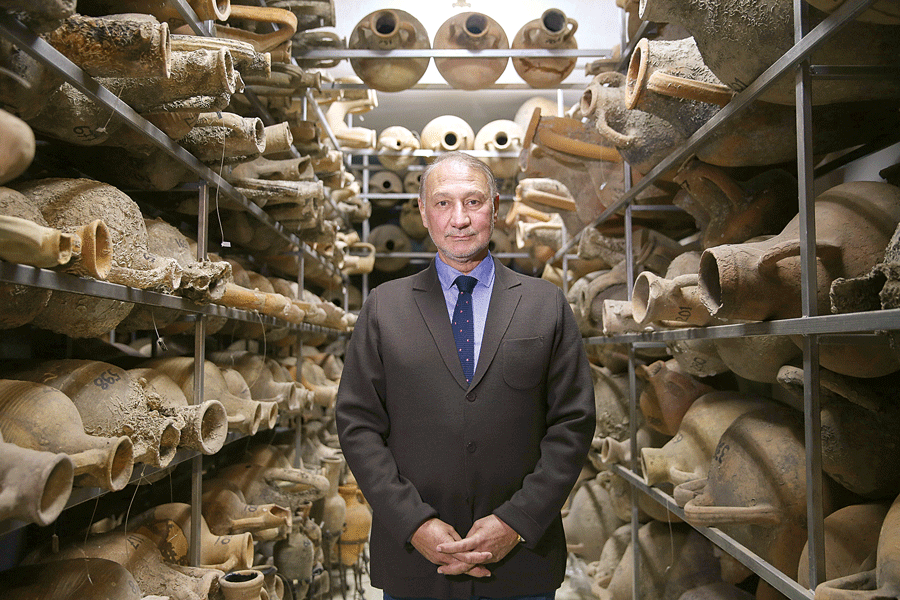Ancient maritime pieces await Turkish museum
ISTANBUL

Under the guidance of the world’s largest private amphora collection, work is underway to establish the Amphora and Maritime Museum, where the archaic, classical, Hellenistic, Roman and Byzantine periods will be described with information, documents, posters, sculptures, reliefs, maps and mock-ups, in Turkey.
While the Unites States has 210 maritime museums and 240 museum ships and the United Kingdom has 250 maritime museums and 450 museum ships, Turkey has very few.
The establishment of a comprehensive maritime museum in Turkey, which is surrounded by three seas, is of great importance in terms of maritime history. In addition, it is possible to establish more than one maritime museum in different provinces with the thousands of pieces in the collectors’ inventory.
Mustafa Aydemir, who has devoted his life to seas and possesses the richest amphora collection in the world, has been working for years to evaluate his possessions related to the sea at an Amphora and Maritime Museum that would be established in any Turkish province.
In order to fill this gap in Turkey, Aydemir started working with ancient bronze and ceramic works collector Haluk Perk, Steam Age collections general consultant Selçuk Kolay, museum art consultant Bahattin Öztuncay, museum display and merchandising specialist Mine Küçük, medals and insignia expert Cem Mahruki, coins consultant Hüsnü Öztürk, photographer Akadur Töleğen, financial and legal adviser Humral Tan, and graphic designer Yüksel Çetin. Aydemir continues his search to find financial support for the establishment of the Amphora and Naval Museum, where 5,000 years of maritime history will be shown.
The museum is expected to contribute to the development of the maritime culture and transfer the information about Turkish and the world maritime to the next generations. Visitors of the underwater section of the Maritime Museum will be able to go on a historical journey with amphorae and see the symbols, paintings, maps, statues, clothes and food cultures of ancient civilizations.
Aydemir’s amphora collection, which consists of 1 million pieces, will be one of the most important inventories of this museum.
This special collection, which was brought together with the purchase of amphorae that got caught in fishing nets in the Mediterranean, Black, Aegean and Marmara seas, is still the largest private collection in the world. The collection includes pieces from the archaic, classical, Hellenistic and Greek, Roman and Byzantine periods.
Within the museum, there will be narrations about the maritime culture, trade culture, social life culture, important people of the period, and viticulture.
The museum will also include an exhibition area where the world’s maritime history is narrated, as well as the Ottoman and Turkish maritime history and contemporary transportation elements will be told. The conference hall and an area where underwater archeology and underwater equipment will be exhibited will also be a part of the museum.
In an aquarium, which will be located in the underwater section of the museum, architectural elements such as building blocks, an ancient sunken city image will be created with architectural elements like columns and column heads. The decor in the aquarium will include a sunken ship, an ancient sunken city and amphorae with historical artifacts scattered around it. The fish and other creatures in the aquarium will be living species in the seas around Turkey.
‘Our goal is to tell maritime history of this region’
Speaking to the state-run Anadolu Agency about the museum project, Aydemir said that Turkey’s need for maritime museums was discussed at a panel organized with the scope of the Koç University Maritime Forum (KÜDENFOR).
At the end of the meeting, Aydemir explained that he was appointed as the chairman of this platform and formed his team to start works for the museum.
Speaking of the amphorae, the main elements of the museum, Aydemir said, “Amphorae are secretive cubes of the seas. Because every amphora tells about its period thousands of years ago, especially the coast of Anatolia, the history of the sea, overseas trade and the productions of that period. Therefore, we determined the main theme of the museum as ‘journey to the history of the sea under the guidance of amphorae’.”
Stating that in addition to the amphorae, he said the museum will also display coins, glass and bronze artifacts, maps and models of ships, describing those periods.
“Our goal is to tell people the maritime history of this geography. The first rule of raising seafarer generations is to give the culture of the sea. Marine culture is given only in these maritime museums. Unfortunately, we are the poorest country in the world in terms of maritime museums. We are located in the eastern Mediterranean and have the world’s oldest wrecks on all our shores. The science of underwater archeology in the world developed on these shores. We want to show the maritime history through these wrecks and amphorae. We have been in this region for thousands of years, but unfortunately, we have not been a truly maritime society. We did not understand the importance of the sea,” he said.
Stating that the museum project needs a budget of 5-10 million Turkish Liras, Aydemir said municipalities, corporations and private companies should realize the importance of this issue.
















